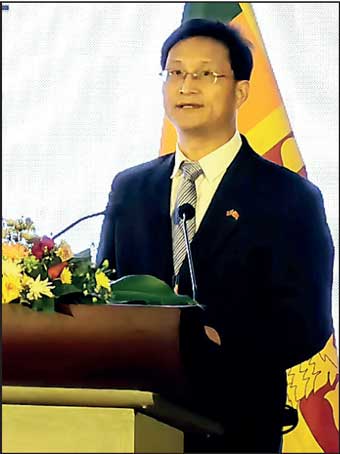Tuesday Dec 16, 2025
Tuesday Dec 16, 2025
Friday, 31 October 2025 00:23 - - {{hitsCtrl.values.hits}}
 |
| China’s Ambassador to Sri Lanka Qi Zhenhong |
China’s Ambassador to Sri Lanka Qi Zhenhong on Wednesday said broader use of the Chinese Yuan, or Renminbi (RMB), could strengthen Sri Lanka’s macroeconomic stability and help lower foreign-exchange risks as the country seeks to rebuild from its recent economic crisis.
Speaking at the RMB Internationalisation Forum in Colombo, Qi said that for a developing country like Sri Lanka, this process is of significant and practical importance.
“Broader use of the RMB helps diversify the structure of foreign-exchange reserves, reduce exchange-rate risk, and provide more stable and lower-cost settlement channels in bilateral trade, investment and financing, thereby strengthening the local currency’s stability and macro-economic resilience,” Qi said.
He described the RMB’s internationalisation as a market-driven, enterprise-led, risk-controllable and gradual process, adding that it would inject fresh momentum into trade facilitation, investment attraction and financial-system modernisation in Sri Lanka.
“Expanding cooperation with China through the RMB would be timely as Sri Lanka undergoes “a critical period of economic recovery and structural adjustment,” the Ambassador noted.
In outlining the progress of the Chinese currency’s global adoption, Qi said that in the first half of 2025, cross-border RMB receipts and payments totalled RMB 35 trillion (about $ 4.9 trillion), up 14% year-on-year.
Over 80 countries and regions now hold RMB in their foreign-exchange reserves, while Hong Kong has developed into the core offshore hub, with complementary markets in London, Singapore and Dubai.
He noted that RMB deposits in major offshore markets amount to about RMB 1.6 trillion, and the outstanding volume of offshore RMB and Panda Bonds has reached around RMB 2 trillion.
The Cross-Border Interbank Payment System (CIPS), China’s global settlement platform, has 1,729 participants covering over 5,000 licensed banking institutions across 189 countries and regions.
“The cross-border use of the digital yuan (e-CNY), along with rapid domestic and cross-border payments and QR-code interoperability, is steadily progressing, further improving the efficiency of cross-border settlements,” Qi said.
Currently, RMB clearing banks have been established in 33 countries and regions, and the currency accounts for 12.28% of the International Monetary Fund’s Special Drawing Rights basket, ranking third after the US Dollar and the Euro.
The People’s Bank of China has signed 32 bilateral currency-swap agreements with counterparts including the European Central Bank and the central banks of New Zealand, South Korea, Indonesia, Brazil and Saudi Arabia, with a total scale of RMB 4.5 trillion.
Qi said broader use of the RMB simplifies procedures, lowers transaction costs and enables enterprises to hedge risks more effectively.
“China’s attitude toward RMB internationalisation has always been prudent and pragmatic. Its aim is to make the global financial system more diversified and more stable, and to give developing countries more space for equal participation and sharing of opportunities,” he said.
Qi also noted that since the establishment of the United Nations 80 years ago, the international monetary system had remained dominated by the US Dollar, first under the Bretton Woods fixed-exchange-rate system and later under the Jamaica Agreement’s floating-rate regime.
“Over the long run, this system provided institutional underpinnings for global economic recovery and trade prosperity. However, as the global economic landscape undergoes profound adjustment, the Dollar-centric system has gradually exposed its structural contradictions, imbalances in liquidity provision, spill-over of financial risks, and the marginalisation of developing countries’ interests,” Qi added.
He cited former US Treasury Secretary John Connally’s 1970s remark that “the dollar is our currency, but it’s your problem,” adding that such dominance meant policy changes in major economies had a tidal effect on the rest of the world.
“Once a major economy tightens policy rapidly to curb inflation, capital retrenchment accelerates, and developing countries may be forced to suffer from exchange-rate shocks, rising financing costs, and setbacks to growth,” Qi said.
He argued that reforming the international monetary framework to make it more equitable, stable and inclusive has become a shared goal.
“As the world’s second-largest economy and a major trading nation, China is actively participating in reform of the international monetary system and steadily promoting the internationalisation of the RMB,” he said.
Qi urged closer cooperation.
“We are ready to work with all parties to uphold the principles of extensive consultation, joint contribution and shared benefits, making the RMB an important piece in the diversified mosaic of the international monetary system.”
He said China hoped that through continued dialogue and cooperation, it will gather consensus, pool wisdom, translate intellectual outcomes into pragmatic action, and together push the internationalisation of the RMB to a new level.